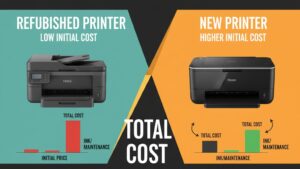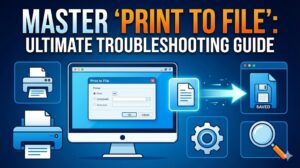If you want to save money on printing without sacrificing quality or productivity, you’re facing one of the most common office and home expenses that spirals out of control. The average American household spends over $400 annually on printing supplies, while small businesses often allocate 1-3% of their total revenue to printing costs. These expenses can quickly add up, especially when you factor in ink cartridges, paper, maintenance, and equipment replacement.
The printing industry has long been criticized for its “razor and blade” business model, where printers are sold cheaply but consumables carry premium prices. However, with strategic planning and smart purchasing decisions, you can dramatically reduce your printing expenses without compromising on the quality or quantity of your printed materials.
These proven cost-cutting strategies will help you slash your printing budget by up to 60% while maintaining professional results for both personal and business use.
What Are Budget Printing Solutions?
Budget printing solutions encompass a comprehensive approach to minimizing printing costs through strategic equipment choices, smart consumable purchasing, efficient usage practices, and proper maintenance routines. This concept goes beyond simply buying cheaper supplies and instead focuses on maximizing value and efficiency across your entire printing ecosystem.
Effective budget printing involves understanding the true cost per page of different printing methods, comparing long-term expenses rather than just upfront costs, and implementing practices that extend equipment life while reducing waste. It requires analyzing your actual printing needs versus habits and finding the optimal balance between quality and cost for different types of documents.
The foundation of budget printing lies in recognizing that printing costs include more than just ink and paper. Equipment depreciation, maintenance, energy consumption, and time spent managing printing tasks all contribute to the total cost of ownership. Smart budget printing addresses all these factors systematically.
Modern budget printing solutions also leverage technology advances like high-yield cartridges, refillable ink systems, and digital alternatives that can dramatically reduce per-page costs while maintaining professional quality standards for business and personal use.
9 Proven Strategies to Save Money on Printing

1. Choose the Right Printer for Your Budget
The most impactful way to save money on printing long-term is selecting a printer with low operating costs rather than focusing solely on purchase price. Calculate the cost per page for both black and color printing before making your decision.
Laser printers typically offer lower per-page costs for black text documents, especially for high-volume printing. While the initial investment is higher, the long-term savings can be substantial for users who print frequently.
For occasional users, inkjet printers with individual color cartridges provide flexibility and prevent waste when only one color runs out. Avoid printers with combined color cartridges if you print regularly.
2. Buy Compatible or Refillable Cartridges
Compatible cartridges from reputable third-party manufacturers can reduce ink costs by 50-80% compared to original manufacturer cartridges. Look for suppliers offering satisfaction guarantees and choose brands with positive reviews.
Refillable cartridge systems, like Epson’s EcoTank series or Canon’s MegaTank models, offer the lowest per-page costs for high-volume users. While the initial investment is higher, these systems can pay for themselves within months for regular users.
Always keep backup cartridges to avoid emergency purchases at retail stores, where prices are typically 20-40% higher than online sources.
3. Optimize Your Print Settings
Adjust print quality settings based on document purpose. Use draft or economy mode for internal documents, emails, and rough drafts. These settings can reduce ink consumption by 30-50% while maintaining readability.
Print in grayscale whenever possible to preserve color cartridges. Configure your printer to default to grayscale for routine documents, switching to color only when necessary.
Enable duplex (double-sided) printing to cut paper costs in half. Most modern printers support automatic duplex printing, which also reduces storage space for printed documents.

4. Strategic Paper Purchasing
Buy paper in bulk during sales to reduce per-sheet costs. Warehouse stores and online retailers often offer significant discounts on larger quantities, but ensure you have proper storage space.
Choose appropriate paper weights for different purposes. Standard 20lb copy paper works fine for most documents, while heavier weights are only necessary for presentations or client-facing materials.
Consider generic or store-brand papers for routine printing. Many generic papers perform identically to name brands at 20-30% lower costs.
5. Implement Smart Printing Habits
Use print preview to eliminate reprints due to formatting errors or unwanted pages. This simple habit can reduce paper and ink waste by 15-25% for most users.
Print multiple pages per sheet for draft reviews and reference documents. Two or four pages per sheet dramatically reduces both paper and ink consumption for reading materials.
Avoid printing emails and web pages unless absolutely necessary. Use digital highlighting and annotation tools instead of printing for markup purposes.

6. Maintain Your Printer Properly
Regular maintenance prevents costly repairs and extends equipment life. Clean printer heads monthly to prevent clogs that waste ink during cleaning cycles.
Keep your printer in a dust-free environment and use it regularly. Printers that sit unused for weeks often develop problems requiring expensive cleaning cycles or repairs.
Replace maintenance kits and consumables according to manufacturer schedules to prevent major breakdowns that could require expensive repairs or premature replacement.
7. Take Advantage of Bulk Printing Services
For large jobs like wedding invitations, business cards, or marketing materials, online printing services often provide better value than home printing. Compare costs including your time and materials.
Local print shops frequently offer competitive pricing for high-volume jobs and can provide professional finishing services that aren’t possible with home printers.
Consider print-on-demand services for variable data printing or small quantities of professional materials rather than investing in specialized equipment.

8. Use Digital Alternatives When Possible
Implement digital document management systems to reduce the need for physical copies. Cloud storage and mobile apps can eliminate much routine printing.
Use electronic signatures and digital forms instead of printing, signing, and scanning documents. This saves time, paper, and ink while improving workflow efficiency.
Share documents electronically whenever possible rather than printing copies for distribution. Email, shared drives, and collaboration platforms reduce printing needs significantly.
9. Monitor and Track Printing Costs
Keep detailed records of printing expenses to identify cost-saving opportunities. Track ink usage, paper consumption, and maintenance costs to understand your true printing expenses.
Set printing budgets and quotas for family members or employees to encourage conscious printing decisions. Many printers offer usage tracking features that help monitor consumption.
Calculate cost per page regularly to ensure your printing methods remain cost-effective. This metric helps you make informed decisions about when to print versus when to use alternatives.

Additional Insights and Tools for Maximum Savings
Beyond basic cost-cutting strategies, several advanced approaches can further reduce your printing expenses. Print management software can track usage patterns, enforce printing policies, and automatically apply cost-saving settings across multiple devices in business environments.
Many manufacturers offer subscription services for ink delivery that can provide modest savings and convenience, though these aren’t always the most economical option compared to bulk purchasing compatible cartridges during sales events.
Consider joining warehouse clubs or office supply store membership programs that offer exclusive discounts on printing supplies. The annual membership fees often pay for themselves through supply savings for regular users.
For businesses, implementing follow-me printing systems can reduce waste by requiring users to authenticate at the printer before jobs are printed, eliminating forgotten print jobs that waste resources.
Troubleshooting Common Money-Wasting Mistakes
One of the biggest mistakes when trying to save money on printing is buying extremely cheap compatible cartridges that produce poor quality results or damage printers. While compatible cartridges can offer excellent savings, research suppliers carefully and avoid suspiciously low-priced options.
Another costly error is running printers until cartridges are completely empty. This practice can damage print heads and require expensive cleaning procedures. Replace cartridges when they reach 10-15% capacity to maintain optimal performance.
Many users waste money by not adjusting default printer settings. Most printers ship with settings optimized for quality rather than economy, leading to unnecessary ink and paper consumption for routine documents.
Improper storage of paper and cartridges can lead to waste and quality issues. Store supplies in cool, dry places away from direct sunlight. Damaged paper can cause jams and waste, while improperly stored cartridges may dry out or leak.
Ignoring maintenance schedules often leads to expensive repairs or premature equipment replacement. Regular cleaning and proper care can extend printer life significantly and prevent costly breakdown repairs.
Don’t overlook the hidden costs of “free” printing at work or public locations. These costs are often built into other fees and may not actually save money when you factor in time and convenience.
Frequently Asked Questions
Q: How much money can I realistically save on printing costs? A: Most users can reduce printing costs by 40-60% through strategic cartridge purchasing, optimized settings, and smart printing habits. High-volume users often see even greater savings with bulk purchasing and refillable systems.
Q: Are compatible ink cartridges safe for my printer? A: High-quality compatible cartridges from reputable suppliers are generally safe and can provide excellent results. Choose suppliers offering guarantees and avoid extremely cheap options that may damage your printer.
Q: What’s the most cost-effective printer type for home use? A: For low-volume users, inkjet printers with individual color cartridges offer flexibility. For high-volume printing, laser printers or inkjet models with refillable tank systems provide the lowest per-page costs.
Q: How can I reduce printing costs in a small business? A: Implement print policies, use print management software, buy supplies in bulk, and train employees on cost-effective printing practices. Consider outsourcing large jobs to professional print services when economical.
Conclusion
Learning how to save money on printing requires a strategic approach that considers both immediate costs and long-term value. By implementing these nine proven strategies, you can dramatically reduce your printing expenses while maintaining the quality and productivity you need for both personal and professional use.
The key to sustained savings lies in changing your approach to printing from reactive to proactive. Instead of simply buying supplies when they run out, plan purchases strategically, optimize your equipment settings, and develop habits that minimize waste while maximizing efficiency.
Start with the easiest changes like adjusting print settings and buying compatible cartridges, then gradually implement more comprehensive strategies like bulk purchasing and digital alternatives. With consistent application of these techniques, your printing budget will become a manageable expense rather than a financial burden, freeing up resources for other important priorities while maintaining all the printed materials you actually need.
Print High-Quality Photos at Home: Complete Pro Guide for Perfect Results Read More.





Recent Comments